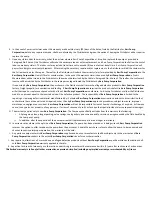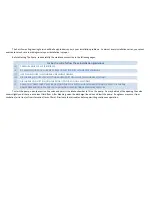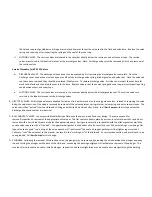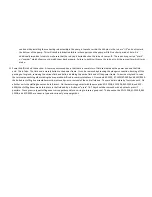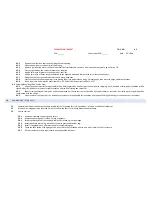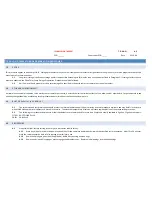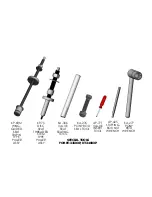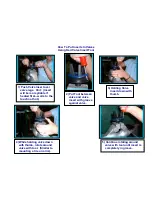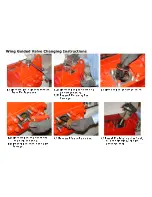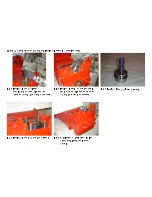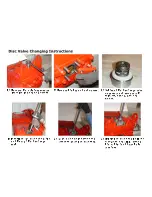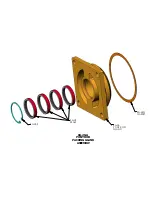
Always
retighten
the
plunger
and
pony
rod
union
periodically
following
the
removal
of
the
plunger
to
insure
it
is
securely
made
up
and
will
not
vibrate
loose.
E.
PLUNGER
PACKING:
This
manual
includes
illustrations
of
the
packing
sets
for
each
model
pump.
Generally,
once
the
plunger
has
been
removed
from
the
pump,
the
packing
can
be
exposed
for
removal
by
completely
removing
whatever
device
is
used
to
tighten
the
packing
(i.e.
the
packing
or
stuffing
box
nut
or
gland).
There
will
be
various
amounts
of
metal
rings
and
packing
components
depending
upon
the
type
of
packing
and
the
model
of
pump
(refer
to
appropriate
illustration
or
chart).
After
the
removal
of
all
rings
and
equipment
from
the
stuffing
box;
thoroughly
clean
it
and
inspect
for
damage,
which
might
keep
the
new
packing
from
working
properly.
If
the
stuffing
box
is
in
satisfactory
condition,
install
the
new
packing
as
per
the
appropriate
illustration.
It
is
a
good
idea
to
lubricate
new
packing
with
a
light
oil
prior
to
installation.
Most
of
the
standard
packing
used
in
pumps
should
be
tightened
with
the
original
equipment
‐
packing
wrench
while
the
pump
is
running
under
normal
operating
pressure.
After
a
two
or
three
hour
run
‐
in,
check
the
packing
for
tightness
and
re
‐
adjust
as
necessary.
Packing
should
be
checked
for
tightness
on
a
periodic
basis,
but
it
is
not
a
good
idea
to
attempt
to
periodically
tighten
the
packing
as
part
of
routine
maintenance.
This
tends
to
“wear
out”
the
packing
prematurely.
When
the
packing
leaks
in
an
excessive
amount
it
should
be
replaced.
There
is
no
value
in
constantly
“re
‐
tightening”
leaking
packing.
If
your
pump
is
equipped
with
optional
“spring
loaded”
packing,
there
is
no
adjustment
in
this
equipment
during
its
operational
life.
The
stuffing
box
nut
is
initially
tightened
as
much
as
possible
and
there
is
no
further
adjustment.
Note:
In
all
cases
the
spring
goes
in
the
stuffing
box
before
the
packing
rings.
When
using
the
optional
Kevlar
or
Teflon
packing,
be
sure
to
rotate
the
“splits”
so
that
none
are
“aligned”
to
insure
that
the
packing
holds
properly.
Normally,
this
packing
is
not
lubricated
and
requires
less
tension
on
the
stuffing
box
nut
during
operation.
CAUTION:
An
“airtight”
seal
is
not
desirable
with
this
plunger
packing.
Some
slight
dripage
is
desirable
during
operation.
Attempts
to
tighten
packing
until
it
completely
“seals
off”
will
result
in
premature
failure
from
too
much
friction.
The
Kevlar
&
Teflon
packing
must
be
allowed
to
drip
a
small
amount
to
assure
normal
life.
F.
PONY
ROD
and
PONY
ROD
PACKING:
Kerr
Pumps
use
two
pony
rod
sealing
arrangements,
models
KD
‐
1250,
KJ
‐
2250,
KM
‐
3250
and
KCP
‐
6300
use
a
screw
in
seal
gland,
all
other
models
use
a
bolt
in
seal
gland,
these
glands
use
press
in
oil
seals
with
snap
ring
retainers.
Some
Bolt
in
gland
use
adjustable
packing
arrangements
with
bolt
in
or
screw
in
followers
to
adjust
packing.
By
unscrewing
plunger
from
pony
rod
a
gap
may
be
facilitated
to
allow
the
removal
of
the
various
sealing
arrangements.
A
special
wrench
will
be
needed
to
remove
and
replace
pony
rod
to
crosshead.
(This
wrench
is
available
from
Kerr
Dealers
)
All
pony
rods
have
a
jam
nut
to
align
tighten
pony
rod
to
crosshead,
care
must
be
exercised
in
installing
new
seal
on
pony
rod
not
to
damage
it.
Summary of Contents for KT-3350XP
Page 19: ......
Page 22: ......
Page 24: ...KA 26G KA 28S GLAND GASKET KA 26 PONY ROD KA 28 SEALS KA 26 A PONY ROD PACKING GLAND ASSEMBLY...
Page 26: ......



